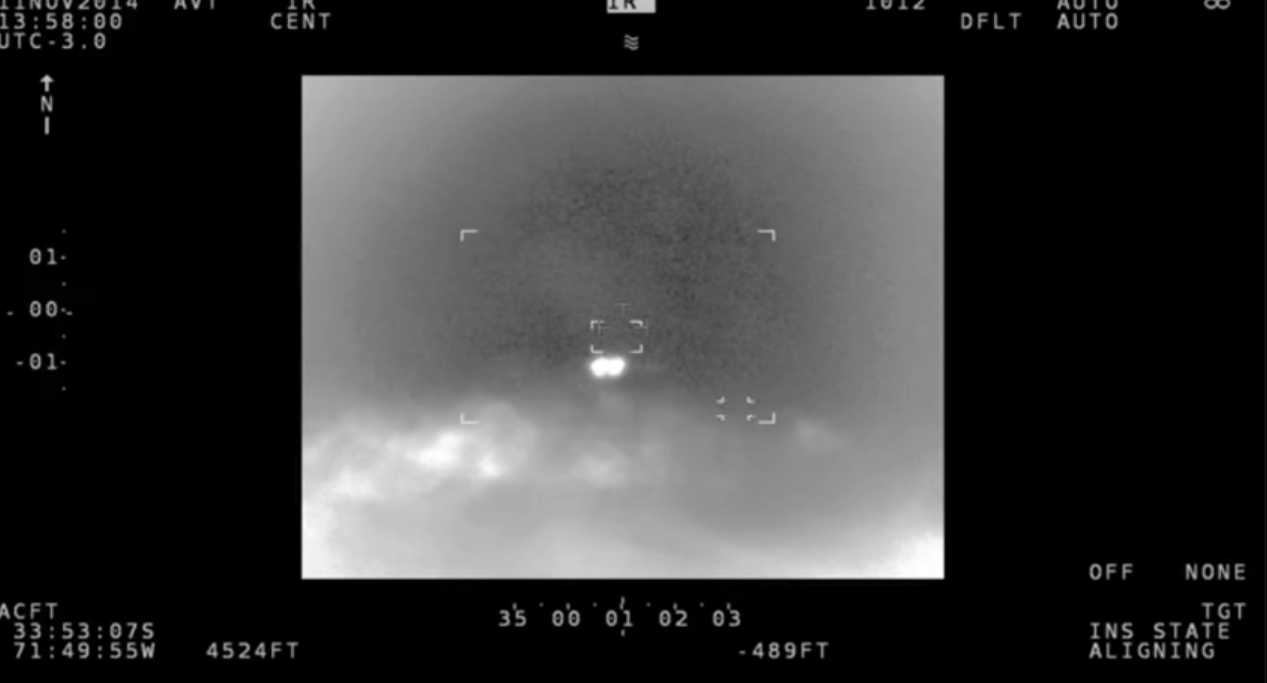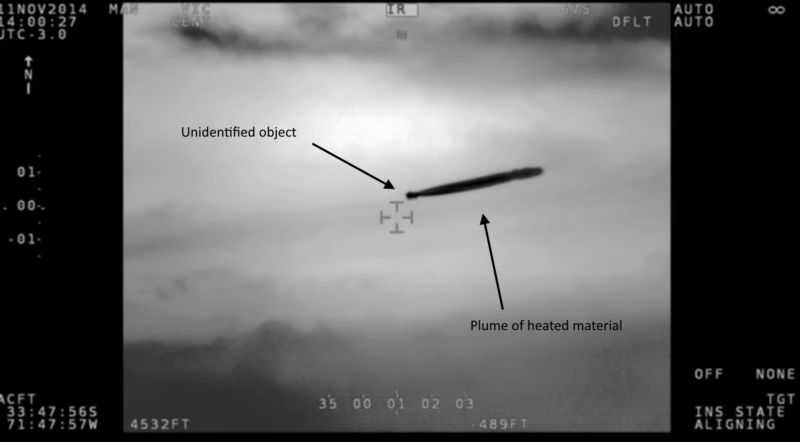In November 2014, a routine patrol by the Chilean Navy near the capital Santiago, between San Antonio and Quintero, in the Valparaiso region led to an unexpected encounter with an unidentified aerial phenomenon (UAP). While the technician tested the newly installed high-definition infrared camera equipped on the Navy helicopter, it captured two large overlapping orbs.
The thermal camera’s readout indicated that the object was hotter than everything else in the frame and that its speed matched that of the navy helicopter, which was flying at 130 knots. However, the most intriguing part of the footage was the appearance of two plumes released by the object, not once but twice. The plumes appeared to be emitting some form of gas or vapor and were visible only in the infrared setting, not the optical viewer.
The Chilean Navy, which openly investigates UAPs, studied the video for two years before releasing it to the public. The government concluded that the object had the characteristics of a UAP, including its ability to avoid detection by radar and its lack of response to communication attempts by the navy crew.
In 2017, the Committee for the Study of Anomalous Aerial Phenomena, a body linked to the Directorate General of Civil Aviation (DGAC), classified the 2014 case as an “unidentified aerial phenomenon.”

The video depicts two connected white circular lights or hot spots, giving off much heat (left). This image was part of an analysis by astrophysicist Luis Barrera. “Envoltura” means “envelope. Credit: CEFFA

A screen grab from a Chilean Navy video showing an odd signature in the infrared.
Experts who analyzed the footage provided various hypotheses but no definitive explanation. Some speculated that the object might have been a hostile craft trying to infiltrate Chilean airspace, although drone or balloon technology did not seem to fit the object’s characteristics.
Others suggested that the plumes could be contrails from a commercial jet flying at a low altitude, which would explain their irregular pattern and appearance. However, the absence of a corresponding radar signature and the object’s trajectory towards Santiago, a city with over 4 million people, raised concerns about a possible threat.
As per reports, the helicopter had a navy captain with extensive flying experience and a technician who was testing a new infrared camera for intelligence, surveillance, and reconnaissance operations. The helicopter was flying at an altitude of around 4,500 feet, with great visibility and a temperature of 10 degrees Celsius. It was traveling at a speed of about 240 km/h.
At 1:48 pm, while testing the camera, the technician spotted a UFO flying to the left of the helicopter over the ocean. Shortly afterward, the object was visible to the naked eye. The two crew members realized that the object’s speed and altitude were similar to that of the helicopter, and the distance between them was roughly 55 to 65 kilometers.

The crew immediately focused the camera on the object and began recording it for roughly 10 minutes. They contacted two radar stations, one near the shore and the other at the DGAC’s central control system in Santiago. However, neither of the radar stations could detect the object, despite quickly identifying the helicopter. The controllers confirmed that there was no traffic in the area, neither military nor civilian and that no aircraft were permitted to fly there. The object was not detected by either the helicopter’s radar or the camera’s radar.
Following protocol, the pilot tried to contact the object via designated channels but received no response. For a duration of 9 minutes and 12 seconds, the technician was able to acquire infrared footage of the object, which primarily generates monochrome images that vary in tone based on temperature. The footage ends when the helicopter is called back to base, and the object disappears into the clouds.
Investigative journalist Leslie Kean, known for her research on UFOs, conducted interviews with key individuals and obtained access to case records. In a report for the Huffington Post, she shared additional information about the event and described it as a “groundbreaking UFO video.”

As soon as the Navy obtained the footage, they handed it over to the CEFAA (the Chilean government agency which investigates UAPs or UFOs). General Bermúdez, together with nuclear chemist Mario Avila, a member of the Chilean Air Force scientific committee, conducted interviews with the two officers at their Navy base.
The Navy Captain stated that the object was a “flat, elongated structure” with “two thermal spotlights like discharges that did not coincide with the axel of motion.” The technician described it as “white with a semi-oval shape on the horizontal axis.” The technician stated: “in two instances it [the craft] discharged some type of gas or liquid with a high thermal track or signal.”
Kean wrote: “The French analysts proposed that the object was a ‘medium-haul aircraft’ coming in for a landing into the Santiago airport, and the effluent trail observed on two occasions probably results from dumping some cabin waste water, forming a plume oriented along the local wind blowing from the west.” They based this on their calculation that the distance between the two hot spots was “consistent with the standard distance between the two jet engines of a medium-haul aircraft.”
Chilean experts dismissed the possibility of it being a conventional aircraft, as it would have been seen on radar, needed clearance to land, and would have responded to radio communications. It was also noted that the plume ejected from the object was not water, as it would have fallen to the ground given the warm air temperature.
The altitude of the UAP was confirmed to be the same as the helicopter by French calculations, and meteorologists ruled out weather balloons and drones. The Chilean Navy and government investigated the incident and concluded that it was an unexplained UAP sighting. The incident was widely reported, including in the New York Times and the Huffington Post, and continues to generate interest in the UAP phenomenon.
The Chilean Navy’s encounter with a UAP resembles other reported sightings around the world, including by the U.S. Navy’s Tic Tac incident, which was captured on video by F/A-18 fighter jets in 2004. However, the Chilean video provides additional evidence that the phenomenon is not limited to one country or region.
Despite the lack of a definitive explanation for the Chilean UAP, its existence challenges conventional notions of aerospace technology and raises important questions about national security and scientific inquiry. As more countries and organizations acknowledge the reality of UAPs, the need for a coordinated and transparent approach to their study and management becomes increasingly urgent.